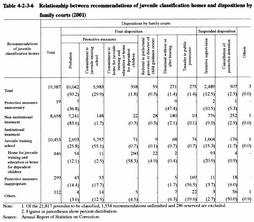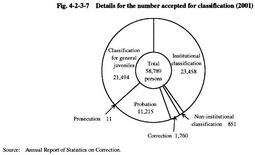| Previous Next Index Image Index Year Selection | |
|
|
3 Classification activities Fig. 4-2-3-5 shows the flow of regular institutional classification of juveniles who have received an adjudication of protective detention given by a family court (hereinafter referred to as "Institutional Classification" in this section). The survey for Institutional Classification comprises interview for classification, physical checkup, psychological test, psychiatric examination and diagnosis, behavior observation, and the gathering of information from related organizations and family members, etc. Information obtained from the result of such investigations is brought together in a classification meeting consisting of the director of the juvenile classification home, persons in charge of classification, and others. The aim of the meeting is to identify the characteristics and problems of the juvenile's predisposition, as well as factors leading to the involvement of the juvenile in delinquency and the risk of recurrence of delinquency. Then, the treatment plan, etc., deemed most appropriate for the juvenile's improvement and rehabilitation is adopted as the opinion on classification. This opinion is summarized in the pre-trial classification report, to be presented to the family court prior to the hearing.
Fig. 4-2-3-5 Flow of institutional classification of juveniles who have received an adjudication of protective measures given by a family court The result of classification is recorded in a Juvenile Book along with other records, to be sent to the juvenile training school, probation office, etc., in case of adjudication for protective measures. If adjudication is made to commit the juvenile to a juvenile training school, guidelines for treatment are formulated. The guidelines are sent with the juvenile to the training school to facilitate the formulation of an individual treatment plan.Table 4-2-3-6 shows the relationship between the recommendations of juvenile classification homes and dispositions by family courts concerning the juveniles for whom classification has been completed out of the Institutional Classifications in 2001. Among the juveniles for whom non-institutional treatment mainly based on probation was recommended, 83.6% were subjected to probation and 9.0% were placed under tentative supervision by family court probation officers with suspended disposition. As for juveniles for whom commitment to juvenile training schools was recommended, 55.1% were actually sent to juvenile training schools, but 25.8% were placed under probation and 15.3% under the aforementioned tentative supervision. As for juveniles who were deemed inappropriate for protective measures, mainly based on a transfer to a public prosecutor, 56.6% were placed under the transfer to a public prosecutor. Table 4-2-3-6 Relationship between recommendations of juvenile classification homes and dispositions by family courts (2001) Other than Institutional Classification, Juvenile classification homes implement the following classification activities. The number accepted for each type of classification in 2001 is shown in Fig. 4-2-3-7.[1] Non-institutional classification at the request of a family court: Non-institutional classification is conducted by summoning juveniles to family courts, juvenile classification homes, etc. without accepting the juveniles at juvenile classification homes. Investigations for classification are mostly made through interviews and psychological tests. The result of classification is summarized in the pre-trial classification report to be submitted to family courts in the same way as the report of Institutional Classification. [2] Juvenile classification activities at the request of the relevant institutions of the Ministry of Justice as follows: - Public prosecutors offices: mostly summary expert examination of juveniles at the stage of criminal investigation. - Correction (penal institution): classification on predisposition in order for the juveniles under 16 who were sentenced to imprisonment with or without labor. - Correction (juvenile training schools): mostly re-classification of juveniles for whom changes in treatment plan need to be considered by reviewing relevant matters. - Probation (Regional Parole Boards and probation offices): mostly classification of juveniles necessary for release on parole proceedings or the execution of probationary supervision. [3] General juvenile classification: General juvenile classification is conducted in most cases at the request of citizens, public and private organizations, etc., in order to contribute to decisions on policies for education, vocational guidance and other kinds of development and guidance of juveniles in the society at large. Through such activities, juvenile classification homes play the role of juvenile guidance centers in local communities, respond to the needs of the population in general, and contribute to the sound development of juveniles, the prevention of juvenilede linquency, etc. Fig. 4-2-3-7 Details for the number accepted for classification (2001) Explanation of termsProtective detention: This is a measure to preserve the custody of a juvenile given by the family court, when a hearing is necessary to be performed. There are 2 types of custody: the case where the juvenile is under the protective detention of a family court probation officer and the case where the juvenile is in the custody of a juvenile classification home. In the latter case, protective detention is carried out for the purpose of providing juveniles with treatment based on the classification of their mental and physical conditions in addition to retaining them in custody. |


